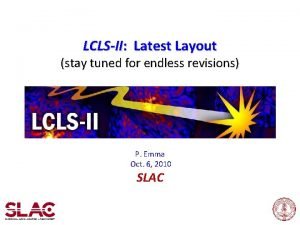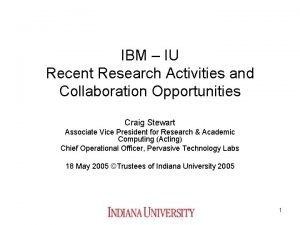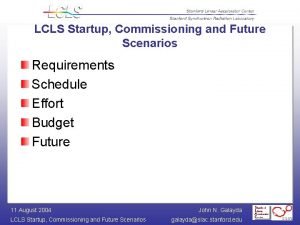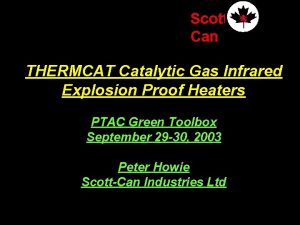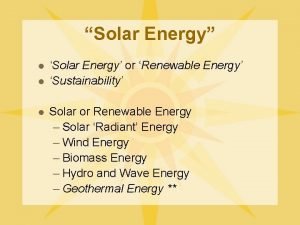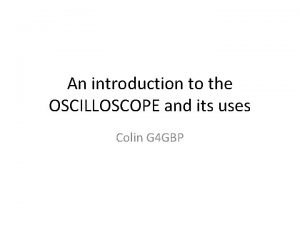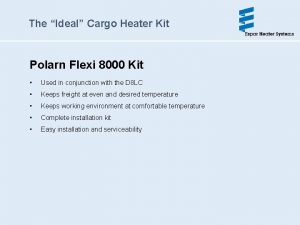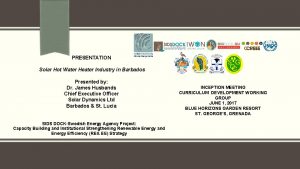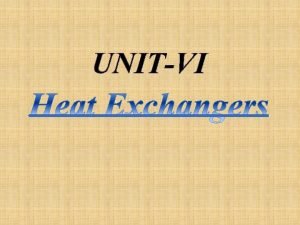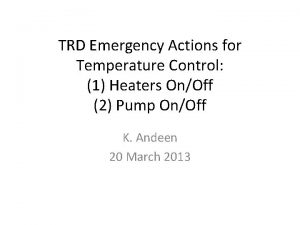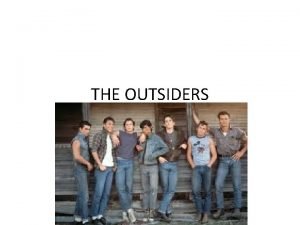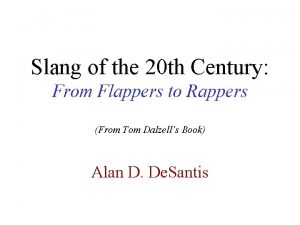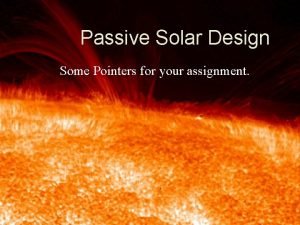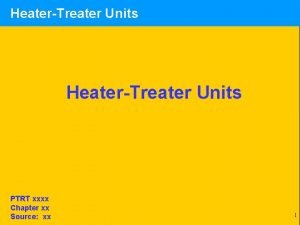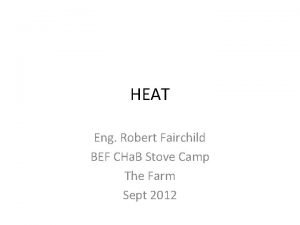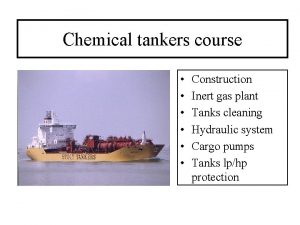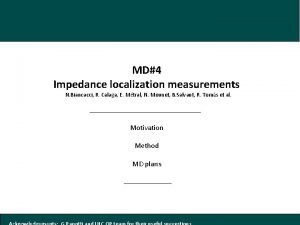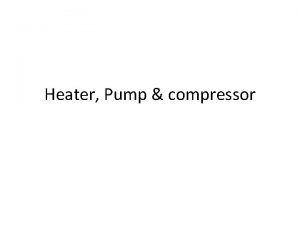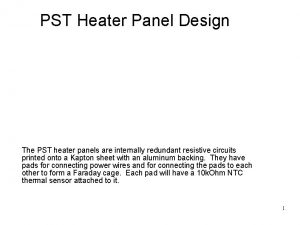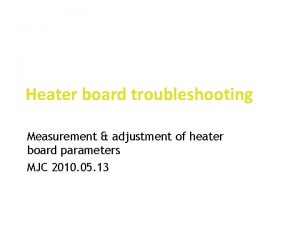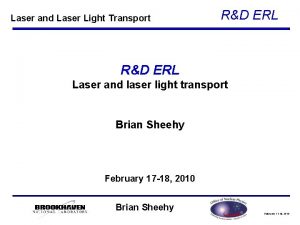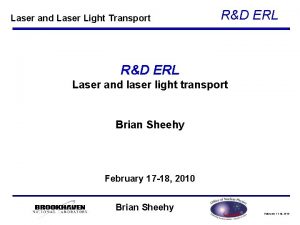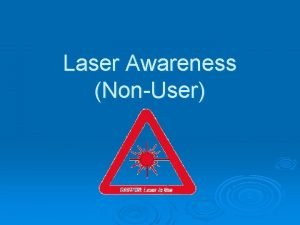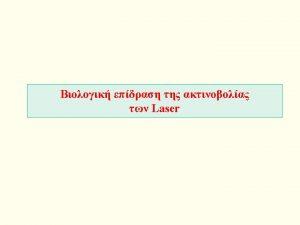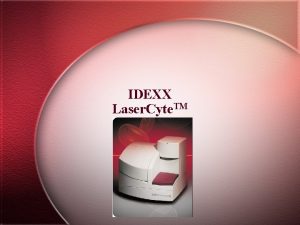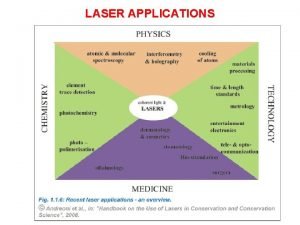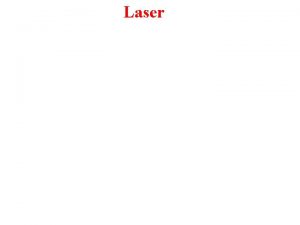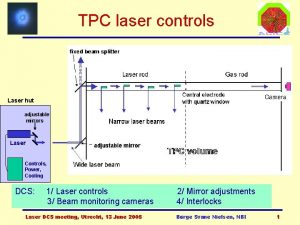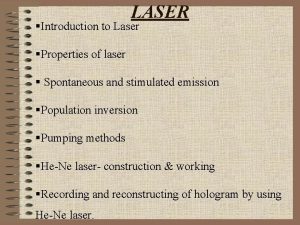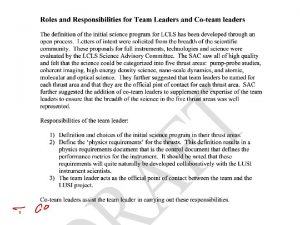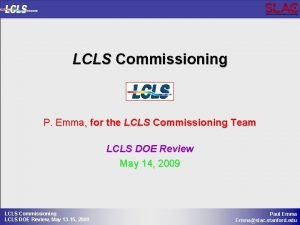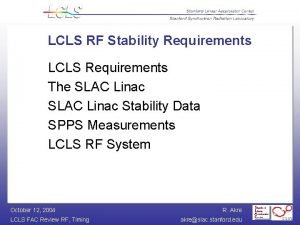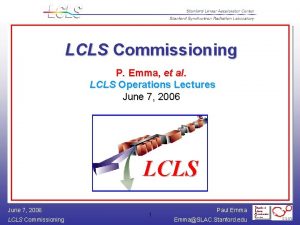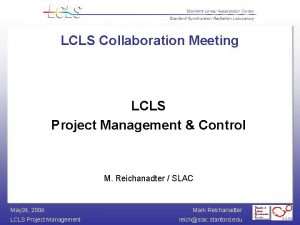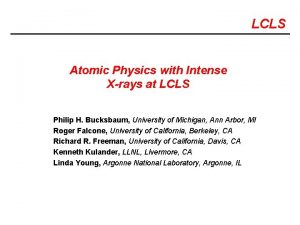Measurements of the LCLS Laser Heater and its


























- Slides: 26

Measurements of the LCLS Laser Heater and its impact on the X-ray FEL Performance Z. Huang for the LCLS commissioning team FEL 2009, Liverpool, UK August 26, 2009 Zhirong Huang zrh@slac. stanford. edu

Outline • Why a Laser heater? LCLS setup and measurements Effects on FEL performance Anomalous heating effects FEL 2009, Liverpool, UK August 26, 2009 2 2 Zhirong Huang zrh@slac. stanford. edu

Introduction Ø Beams from photoinjectors have extremely small initial slice energy spread (2 -3 ke. V). Ø Such a “cold’’ beam can undergo a microbunching instability* in linacs and compressors that may ruin beam quality. Ø “Heating” slice energy spread within the FEL tolerance can suppress the instability and make the beam more stable. Ø Many FEL designs call for a laser heater in the injector. Ø First of its kind was installed and commissioned at LCLS * Borland et al. , NIMA (2002); Saldin, Schneidmiller, Yurkov, NIMA (2002); Heifets, Stupakov, Krinsky, PRST-AB (2002); Huang, Kim, PRST-AB (2002). FEL 2009, Liverpool, UK August 26, 2009 3 3 Zhirong Huang zrh@slac. stanford. edu

m-Bunching Landau Damped by Laser Heater Ti: saph 758 nm <15 MW Injector at 135 Me. V 0. 5 -m undulator ‘Laser heater’ suggested by Saldin et al. , NIMA, 2004; independently by J. Galayda 14 Ge. V Without Laser Heater FEL 2009, Liverpool, UK August 26, 2009 LCLS design study: Z. Huang et al. , PRST 2004 (chicane suggested by T. Smith) 14 Ge. V With Laser Heater 4 4 Elegant simulations Zhirong Huang zrh@slac. stanford. edu

How does a laser heater work? Dg. L after chicane after undulator Modulation smeared by half chicane l. L R 52 and angular spread laser peak power laser rms spot size The last half chicane time-smears the energy modulation leaving an effective “thermal” energy spread increase FEL 2009, Liverpool, UK August 26, 2009 5 5 Zhirong Huang zrh@slac. stanford. edu

Outline • Why a Laser heater? LCLS setup and measurements Effects on FEL performance Anomalous heating effects FEL 2009, Liverpool, UK August 26, 2009 6 6 Zhirong Huang zrh@slac. stanford. edu

Layout of the Laser Heater Optics Two cameras for monitoring laser beam MH 2 & MH 3 provide laser pointing control 758 nm IR laser from laser room transport to the tunnel Two OTR screens for spatial alignment Fast photodiode for timing within ~10 ps OTR screens shutter photo diode e. H rt to L o p s n m tra vacuu VHC camera MH 4 wave plate MH 3 power meter FEL 2009, Liverpool, UK August 26, 2009 MH 2 Sasha Gilevich et. al. , CH 1 camera 7 7 Zhirong Huang zrh@slac. stanford. edu

Laser Heater Spatial Alignment IR Calculate and re-alignpoor laserheating? time energy e- good heating Slide from P. Emma One button click (~1 minute) After three iterations, Dave approves it! H. Loos FEL 2009, Liverpool, UK August 26, 2009 8 8 Zhirong Huang zrh@slac. stanford. edu

Laser Heater Temporal Overlap 16 ps OTR 22 L 2 -linac FEL 2009, Liverpool, UK August 26, 2009 BC 2 COTR signal after BC 2 bends (OTR 22 inserted) Laser pulse 10 -20 ps, electron bunch 5 -7 ps Laser timing done by minimizing the COTR signal after BC 2 Laser energy 230 µJ COTR from microbunching suppressed when laser timed Laser delay line in mm (1 ps = 0. 15 mm) 9 9 Zhirong Huang zrh@slac. stanford. edu

Heating Measurements YAGS 2 RF deflector ON energy Laser OFF σE/E < 12 ke. V FEL 2009, Liverpool, UK August 26, 2009 YAGS 2 Laser: 40 µJ σE/E 45 ke. V Laser: 230 µJ σE/E 120 ke. V time 10 10 Zhirong Huang zrh@slac. stanford. edu

Slice Energy Spread YAGS 2 Laser energy 230 µJ σE/E 120 ke. V Laser OFF FEL 2009, Liverpool, UK August 26, 2009 Double-horn when laser spot ~50% larger than transverse electron beam size 11 11 More uniform heating when laser spot matches transverse size of electron beam Zhirong Huang zrh@slac. stanford. edu

Slice-E Spread vs. Laser Energy Anomalous heating(? ? ) No heating < 10 ke. V (limited by resolution) FEL 2009, Liverpool, UK August 26, 2009 Operating point (~7 u. J) 20 ke. V compression ratio 75/14 Ge. V = 1. 1 10 -4 12 12 Zhirong Huang zrh@slac. stanford. edu

No Emittance Growth from Heating • Laser-induced E-spread in chicane does not introduce emittance growth (< 2%) Heater from 45 m. J to 250 m. J, no change in slice emittance Heater off, COTR after LH chicane biases emittance results 6 ps bunch length FEL 2009, Liverpool, UK August 26, 2009 13 13 Zhirong Huang zrh@slac. stanford. edu

Effects on COTR • Unwanted microbunching leads to many COTR problems in LCLS Laser heater suppresses COTR but not to incoherent level OTR 22 L 2 -linac BC 2 OTR 22 (heater off) OTR 22 image, heater full Camera 10 bit depth Camera 5 bit depth laser-heated energy profile non-Gaussian small part of beam escapes heating Microbunching restart from shot noise after a long linac and some R 56 Alternative diagnostics (wires) used for beam profiles after compressors FEL 2009, Liverpool, UK August 26, 2009 14 14 Zhirong Huang zrh@slac. stanford. edu

Outline • Why a Laser heater? LCLS setup and measurements Effects on FEL performance Anomalous heating effects FEL 2009, Liverpool, UK August 26, 2009 15 15 Zhirong Huang zrh@slac. stanford. edu

Laser Heater Improves FEL Power 250 p. C, 3 k. A, 1. 5 Å FEL Laser optimal • FEL saturation length 20 m shorter w/ heater OFF FEL 2009, Liverpool, UK August 26, 2009 Scan unsaturated FEL w/ 12 undulators vs. heater • FEL saturation power improves 2 X w/ heater 16 16 Zhirong Huang zrh@slac. stanford. edu

FEL Gain Length vs. Laser Heater 250 p. C, 3 k. A, 1. 5 Å FEL Heater OFF bunching effectively increases E-spread to 0. 03% ~ 0. 04% level 0. 01% at 14 Ge. V with compression factor 90 FEL 2009, Liverpool, UK August 26, 2009 1. 5 Å 0. 4 - m emit 0. 5 - m emit Heater OFF Heater ON 17 17 Zhirong Huang zrh@slac. stanford. edu

Outline • Why a Laser heater? LCLS setup and measurements Effects on FEL performance Anomalous heating effects FEL 2009, Liverpool, UK August 26, 2009 18 18 Zhirong Huang zrh@slac. stanford. edu

“Trickle” Heating Anomalous heating? ? Trickle heating peaks at ~ 1 m. J FEL 2009, Liverpool, UK August 26, 2009 19 19 Zhirong Huang zrh@slac. stanford. edu

Laser Modulation Hidden in 4 D Phase Space • Laser heater at 0. 5 m. J (Elegant simulation by Y. Ding) Longitudinal phase space Longitudinal after heater chicane after (emittance 0. 5 0. 01 mm) Emittance mm after undulator x-t correlation x’-t correlation (R 52 of half chicane) after heater chicane FEL 2009, Liverpool, UK August 26, 2009 20 20 Zhirong Huang zrh@slac. stanford. edu

Modulation Recovered in Real Space x’-t. correlation spectr YAGS 2 dipole heater x-t correlation FEL 2009, Liverpool, UK August 26, 2009 21 21 Zhirong Huang zrh@slac. stanford. edu

• Longitudinal Space Charge (LSC) x Consider a beam as shown R tilt angle R = Dz/Dx, R is related to transfer matrix z • When x. R > , longitudinal density modulation is suppressed strongly (exponentially if Gaussian distribution in x) • In a 1 D approach (as used in Elegant), longitudinal modulation multiply by 1 D LSC impedance to compute energy modulation amplitude FEL 2009, Liverpool, UK August 26, 2009 22 22 Zhirong Huang zrh@slac. stanford. edu

LSC for Tilted Microbunching Beam clearly modulated for tilted microbunching in 3 D density • If beam size x is much larger than , 3 D calculation shows G. Stupakov, private communications D. Ratner, A. Chao, Z. Huang, FEL 08 LSC depends weakly on R when R<1/ Tilted microbunching does not suppress LSC exponentially. 1 D approach underestimates LSC by a large factor Take L=758 nm, =264, x=60 m, R ~2, 1 D underestimates LSC by a factor ~250! Integrating 3 D LSC over heater downstream beamline for total energy modulation FEL 2009, Liverpool, UK August 26, 2009 23 23 Zhirong Huang zrh@slac. stanford. edu

Comparison with measurements Trickle heating subtract inquadrature Normal heating LSC induced by laser modulation (theory) LSC + normal laser heating (theory) FEL 2009, Liverpool, UK August 26, 2009 24 24 Zhirong Huang zrh@slac. stanford. edu

Summary • Laser heater is used in the LCLS to improve and optimize xray FEL performance at the nominal operating condition. • Microbunching is suppressed but not all COTR is gone alternative diagnostics necessary (wire scanner etc…). • Unexpected “trickle” heating explainable by a 3 D LSC model (Preliminary estimation of 1 D CSR effect is small, any 3 D effect at play? ) • Trickle heating does not affect LCLS operation but may have implications to other laser heater designs as well as lasermanipulations of high-brightness beams. FEL 2009, Liverpool, UK August 26, 2009 25 25 Zhirong Huang zrh@slac. stanford. edu

Thanks to: LCLS project director J. Galayda, all commissioning team members, and collaborators and visitors FEL 2009, Liverpool, UK August 26, 2009 26 26 Zhirong Huang zrh@slac. stanford. edu
 Lcls
Lcls Lcls
Lcls Lcls schedule
Lcls schedule Catalytic heater oil and gas
Catalytic heater oil and gas Cavitation water heater
Cavitation water heater Solar shed heater
Solar shed heater Climax solar water heater
Climax solar water heater Mre heater instructions
Mre heater instructions Water heater tenaga listrik
Water heater tenaga listrik Fired heater performance
Fired heater performance In an oscilloscope tube what is the purpose of the heater
In an oscilloscope tube what is the purpose of the heater Compact heater 4000
Compact heater 4000 Solar water heater barbados
Solar water heater barbados Yuba feedwater heater
Yuba feedwater heater Geyser heat pump water heater
Geyser heat pump water heater A 15 ohm electric heater operates on a 120v outlet
A 15 ohm electric heater operates on a 120v outlet Shell and tube type evaporator
Shell and tube type evaporator Water heater trd
Water heater trd Comic strip
Comic strip Heater 1960 slang definition
Heater 1960 slang definition Trombe wall diagram
Trombe wall diagram Shell and tube heat exchanger in food industry
Shell and tube heat exchanger in food industry Heater treater
Heater treater Serpentine heat exchanger
Serpentine heat exchanger Deck mounted cargo heater
Deck mounted cargo heater Dead weight safety valve
Dead weight safety valve Calagas heater
Calagas heater
